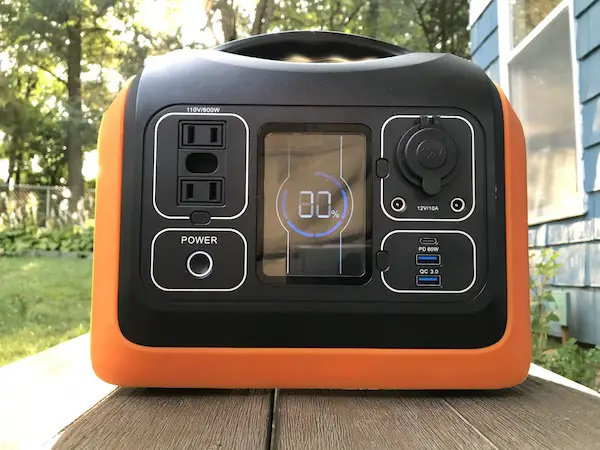As lithium-iron-phosphate (LiFePO4) batteries are becoming more popular in the portable power station industry because of their impressive lifespans, I wanted to get one of these systems for myself.
I decided on the OUPES 600W portable power station and tested it out. The following are my results.
| Pros | Cons |
|---|---|
| LiFePO4 battery (3,600+ cycles) | Side vents are not sturdy |
| 5x different charging methods | Average max charging input |
| Large and informative LCD screen | On the heavier side (15-15.5 lbs) |
The OUPES 600W power station has a 60W USB-C PD and two USB-A QC 3.0 ports, a large LCD screen, and a high AC power output (600W). It’s too heavy to carry for long distances and its side vents are not sturdy, yet it retains its value over time from its LiFePO4 battery with 3,600+ lifecycles.
The OUPES 600W portable power station paired with a 100-120W solar panel is best for backup power at home, inside camper vans, and any other off-grid scenario where powering devices and small appliances are needed.
Specifications of the OUPES 600W Solar Generator

Below you’ll find the basic specs of the OUPES system. After that, I’ll get into my unboxing, input/output testing results, its unique features, and my final thoughts.
| Brand/Model | OUPES 600W |
| Battery Capacity | 595Wh |
| Battery Type | Lithium-iron-phosphate (LiFePO4) |
| Input Ports | (1) USB-C PD port (60W max) (1) DC input for solar/wall/car charging (12-30V, 100W max) |
| Output Ports | (2) 110V AC outlets (600W continuous, 1,000W surge) (2) USB-A QC 3.0 ports (18W max) (1) USB-C PD port (60W max) (1) DC car port (12V/10A, 120W max) (2) DC 5521 ports (12V/5A, 60W max) |
| Weight | 15 lbs |
| Warranty | 24 months |
Unboxing the OUPES Power Station

The OUPES system came very well packaged with two large styrofoam-like cushions to protect the power station.
There were two small cardboard containers that housed the cords for the generator as well.
When I powered up the OUPES, it was already charged to 80% battery. This is great because the battery maintained a healthy charge while it was shipped over to me.
Outer Construction

The orange ends of the OUPES are made of rubber as well as the feet or bottom of the generator.
These rubber installments provide a layer of protection if dropped as well as a grippy undercarriage when placing it down.
The black-colored section of the system is made of hard plastic. However, the vents on the side of it are not as sturdy as the rest of the plastic areas – so much so that if I dropped it on one of the ventilation sides, I think it would break.

I recommend using this power station with caution and making sure that you place it in an area where it will not have a chance of falling on its side.
There is a sturdy handle that is much needed since this system weighs about 15 pounds.
Special Features on the OUPES 600W
I found that the OUPES power station included some additional features that aren’t always found on the average solar-powered generator.
LED Light – 3 Modes

There are a couple of solar generators that come to mind that have LED lights on them – the Jackery Explorer 1000 and EcoFlow River 600, but this is not a standard feature when looking at all the different models on the market.
The light on the OUPES is very bright even in its standard setting. It has three settings: standard, bright, and SOS.
The standard and bright modes are a solid light, while the SOS mode flashes in Morse code.
I’ve tested the light on my Fanttik T8 Apex jump starter and it has similar modes as the OUPES, but the OUPES’ light is brighter and spans wider.
Large LCD Screen
One of the most significant features of the OUPES system is its LCD screen. It’s larger than most other portable power stations which allows it to display more valuable information, including:
- Watts coming in and out
- Battery percentage
- Port icons signaling if they are active/inactive
- A blue charging ring that circles around the battery percentage icon when it’s charging
- A spinning cooling fan icon when its fans are active
12V Car Port Cover

There is a port cover on the 12V car port (cigarette lighter port) which is marine-grade. This helps to keep out any debris that can easily get into the large port.
Smart IC Chip – Battery Protection
There is a chip within the OUPES that monitors the internal components of the power station when in use.
Here are the protective measures that are in place:
- Overload protection
- Smart air cooling
- Over-temperature protection
- Short circuit protection
- Over-discharge protection
There may be a time when a warning signal displays on the LCD screen of the solar generator.
Although I have yet to experience a warning signal on the OUPES, these icons/signals have troubleshooting measures that you can take. All information on fault information and troubleshooting can be found in the included manual.
Nearly all portable power stations have warning icons or some form of protective measures in case something were to malfunction – so this is not necessarily a “special” feature – but every company handles their protective measures differently.
Inverter Fan Signals When AC Port Is Turned On
A subtle feature that I’ve never seen with another solar generator has to do with the AC port button on the OUPES.
When I press the button to turn on the AC port section, the cooling/inverter fan kicks on for less than a second then stops. This is to signal or confirm that I turned on the AC port section.
This feature is especially useful to have in case you accidentally turn the AC ports on. Since the AC ports use an inverter, they use up power even when nothing is plugged in. Having a confirmation like this is a great addition to save any accidental power consumption.
Ports Testing

I tested the USB-A ports as well as the USB-C port separately and together to see if I could get readings similar to the manual’s specifications.
USB-A QC 3.0 Ports
The USB-A ports are both QC 3.0 and can output up to 18W of power to devices.
When I tested these ports on my iPhone and Sherpa 100AC power bank, I got a 12W maximum from each port.

I’m not sure if the 18W maximum was able to be applied to the devices I was charging, but 12W was the maximum I received from each port.
This was consistent no matter which USB ports were also in use.
USB-C PD (In/Out)
The USB-C port worked nearly to the manual’s specs. I got 57W of output and input power from this port.
I simply used my Sherpa power bank for both receiving and outputting power to and from the OUPES generator.
AC Ports

For testing the AC ports, I used the following appliances:
- Air purifier
- Large fan
- Small space heater
I used trial and error to see if I could get to the 600W continuous limit of the OUPES system and managed to get a 567W maximum from all of the appliances plugged into a power strip extending from the power station.

When the power level was at its highest, the OUPES retained the same level of noise from its cooling fans.
I was surprised by this because I tested the Rockpals Rockpower 500‘s AC ports with my space heater and its cooling fans progressively got louder as more power was being used.
Overall, the AC ports worked very well and to specification.
As a side note, I used a power strip with three prongs – The third prong fit into the small hole in between the two AC outlets and this worked with no issues.
Charging the OUPES 600W Solar Generator
There are five methods for recharging the OUPES system:
- USB-C PD
- AC wall charger
- Car charger
- Solar panel
- USB-C PD + wall charger
Solar Charging

On a mostly sunny day in September, I broke out my Elecaenta 120W solar panel to recharge the OUPES power station.
I received a maximum of 82W from the panel and it worked easily to charge the battery up.
The OUPES 600W system can take in up to 100W of solar panel input power and will charge in about six hours with a 100W input.
With its MPPT charge controller, it can take in over 100W of power but will not use the extra power to charge the system. It will divert the extra energy to protect its internals.
Overall, the maximum solar input of the OUPES power station is average when comparing it to the top solar generators in the 500-600Wh category.
| Power Station Model | Maximum Input Power |
|---|---|
| Jackery Explorer 500 | 100W |
| OUPES 600W | 100W |
| Goal Zero Yeti 500X | 150W |
| EcoFlow River Max | 200W |
| Bluetti EB55 | 200W |
Of all the power stations listed above, the Bluetti EB55 and OUPES 600W are the only ones that have a LiFePO4 battery. The EB55 charges much faster than the OUPES from solar panels, which can be a deciding factor when choosing between the two.
You can read my review of the Bluetti EB55 for more specifications here: Test & Review: Bluetti EB55 Solar Generator (In-Depth).
AC Charging
The AC charger that came with the OUPES solar generator has two parts – a power brick and adapter.
These two cords combined measure to about ten feet.
The maximum power output from the AC charger is 96W. When doing my testing, I received about 94W consistently. This will recharge the OUPES power station in about 6-6.5 hours.
Car Charging

The OUPES system also came with a 12V car charger. I used this in my car and received about 48-49W consistently.
At this rate, the OUPES will recharge in about 12 hours from zero battery.
The charger has a red indicator light to show that it is using power from the car’s battery.
Not all solar generators come with car chargers included, so this was a nice bonus.
USB-C PD Charging
As mentioned earlier, I was able to get 57W of power into the OUPES’ USB-C PD port. At this rate, it will charge from zero battery in about 10.5 hours.
USB-C PD and AC Charging
USB-C combined with AC charging will bring in the most amount of power for the shortest recharging time of about four hours from zero to full.
The AC charger will contribute about 95W while the USB-C can get up to 60W into the system.
Should You Get the OUPES 600W Portable Power Station?

I would say that the OUPES portable power station is a great addition to have for small off-grid power needs. With a 600W continuous AC output, it can also power small appliances like mini-fridges and CPAP machines if needed.
Most important of all when considering a solar generator is its long-term value. Since this system has a LiFePO4 battery with 3,600+ cycles, it will last longer than any lithium-ion solar generator of the same size.
For perspective, the Yeti 500X and Jackery Explorer 500 both have ratings of 500 cycles.
If this solar generator seems like a good fit for you, you can find the OUPES power station on Amazon via my affiliate link here. I also have reviews on similar solar generators to the OUPES 600W that you can also find below.
- Rockpals Rockpower 500 Review (Testing, Pricing, and More)
- Yeti 500x by Goal Zero – Overview & Stats – Peak Performance
- EcoFlow River (R600) Solar Generator – Complete Review
You can also watch my review and testing of the OUPES first-hand here:
